PA1-026A
antibody from Invitrogen Antibodies
Targeting: FKBP1A
FKBP-12, FKBP1, FKBP12, FKBP12C, PKC12, PPIASE
Antibody data
- Antibody Data
- Antigen structure
- References [41]
- Comments [0]
- Validations
- Western blot [1]
- Immunohistochemistry [3]
- Other assay [14]
Submit
Validation data
Reference
Comment
Report error
- Product number
- PA1-026A - Provider product page

- Provider
- Invitrogen Antibodies
- Product name
- FKBP12 Polyclonal Antibody
- Antibody type
- Polyclonal
- Antigen
- Synthetic peptide
- Description
- PA1-026A detects FK506 binding protein 12 kDa (FKBP12) in human and mouse tissues. PA1-026A has been successfully used in Western blot, immunohistochemistry, and immunoprecipitation procedures. By Western blot, this antibody detects a 12 kDa protein representing FKBP12 from rat heart homogenate. The PA1-026A immunogen is a synthetic peptide corresponding to the N-terminal residues G(1) V Q V E T I S P G D G R(13) of human FKBP12. PA1-026A immunizing peptide (Cat. # PEP-012) is available for use in neutralization and control experiments.
- Reactivity
- Human, Mouse
- Host
- Rabbit
- Isotype
- IgG
- Vial size
- 100 μL
- Concentration
- 1 mg/mL
- Storage
- -20°C, Avoid Freeze/Thaw Cycles
Submitted references A Proximal-to-Distal Survey of Healthy Adult Human Small Intestine and Colon Epithelium by Single-Cell Transcriptomics.
Calcineurin phosphatase activity regulates Varicella-Zoster Virus induced cell-cell fusion.
Intracellular calcium leak lowers glucose storage in human muscle, promoting hyperglycemia and diabetes.
The mechanistic target of rapamycin pathway downregulates bone morphogenetic protein signaling to promote oligodendrocyte differentiation.
Interplay between Triadin and Calsequestrin in the Pathogenesis of CPVT in the Mouse.
Immunodominant AH1 Antigen-Deficient Necroptotic, but Not Apoptotic, Murine Cancer Cells Induce Antitumor Protection.
FKBP52 regulates TRPC3-dependent Ca(2+) signals and the hypertrophic growth of cardiomyocyte cultures.
Cyclophilin A enables specific HIV-1 Tat palmitoylation and accumulation in uninfected cells.
FKBP12.6 protects heart from AngII-induced hypertrophy through inhibiting Ca(2+) /calmodulin-mediated signalling pathways in vivo and in vitro.
MLKL Activation Triggers NLRP3-Mediated Processing and Release of IL-1β Independently of Gasdermin-D.
RIPK3 Restricts Viral Pathogenesis via Cell Death-Independent Neuroinflammation.
Vaccination with Necroptotic Cancer Cells Induces Efficient Anti-tumor Immunity.
Pancreatic endoplasmic reticulum kinase activation promotes medulloblastoma cell migration and invasion through induction of vascular endothelial growth factor A.
Bone morphogenetic protein 7 regulates reactive gliosis in retinal astrocytes and Müller glia.
The composition of EphB2 clusters determines the strength in the cellular repulsion response.
mTOR pathway and Ca²⁺ stores mobilization in aged smooth muscle cells.
Fkbp1a controls ventricular myocardium trabeculation and compaction by regulating endocardial Notch1 activity.
Targeting colorectal cancer stem cells with inducible caspase-9.
Disparities in the association of the ryanodine receptor and the FK506-binding proteins in mammalian heart.
Prevention of ventricular arrhythmia and calcium dysregulation in a catecholaminergic polymorphic ventricular tachycardia mouse model carrying calsequestrin-2 mutation.
Relieving autophagy and 4EBP1 from rapamycin resistance.
Comparative analysis of different peptidyl-prolyl isomerases reveals FK506-binding protein 12 as the most potent enhancer of alpha-synuclein aggregation.
Reduced gain of excitation-contraction coupling in triadin-null myotubes is mediated by the disruption of FKBP12/RyR1 interaction.
Transgenic analysis of the role of FKBP12.6 in cardiac function and intracellular calcium release.
Localization of the dantrolene-binding sequence near the FK506-binding protein-binding site in the three-dimensional structure of the ryanodine receptor.
Organelle-specific, rapid induction of molecular activities and membrane tethering.
Inhibition of FK506 binding proteins reduces alpha-synuclein aggregation and Parkinson's disease-like pathology.
Differential protein profiling as a potential multi-marker approach for TSE diagnosis.
Expression levels of RyR1 and RyR3 control resting free Ca2+ in skeletal muscle.
Gene silencing in androgen-responsive prostate cancer cells from the tissue-specific prostate-specific antigen promoter.
Protection against ischemic brain damage in rats by immunophilin ligand GPI-1046.
The 12 kDa FK506-binding protein, FKBP12, modulates the Ca(2+)-flux properties of the type-3 ryanodine receptor.
Cyclophilin A is required for retinoic acid-induced neuronal differentiation in p19 cells.
Increased sensitivity of the ryanodine receptor to halothane-induced oligomerization in malignant hyperthermia-susceptible human skeletal muscle.
Early decrease of the immunophilin FKBP 52 in the spinal cord of a transgenic model for amyotrophic lateral sclerosis.
Early decrease of the immunophilin FKBP 52 in the spinal cord of a transgenic model for amyotrophic lateral sclerosis.
Transport activity and surface expression of the Na+-Ca2+ exchanger NCX1 are inhibited by the immunosuppressive agent cyclosporin A and by the nonimmunosuppressive agent PSC833.
Effects of the immunosuppressant FK506 on intracellular Ca2+ release and Ca2+ accumulation mechanisms.
The effects of FK506 on retinal ganglion cells after optic nerve crush.
Identification of a physical interaction between calcineurin and nuclear factor of activated T cells (NFATp).
Identification of a physical interaction between calcineurin and nuclear factor of activated T cells (NFATp).
Burclaff J, Bliton RJ, Breau KA, Ok MT, Gomez-Martinez I, Ranek JS, Bhatt AP, Purvis JE, Woosley JT, Magness ST
Cellular and molecular gastroenterology and hepatology 2022;13(5):1554-1589
Cellular and molecular gastroenterology and hepatology 2022;13(5):1554-1589
Calcineurin phosphatase activity regulates Varicella-Zoster Virus induced cell-cell fusion.
Zhou M, Kamarshi V, Arvin AM, Oliver SL
PLoS pathogens 2020 Nov;16(11):e1009022
PLoS pathogens 2020 Nov;16(11):e1009022
Intracellular calcium leak lowers glucose storage in human muscle, promoting hyperglycemia and diabetes.
Tammineni ER, Kraeva N, Figueroa L, Manno C, Ibarra CA, Klip A, Riazi S, Rios E
eLife 2020 May 4;9
eLife 2020 May 4;9
The mechanistic target of rapamycin pathway downregulates bone morphogenetic protein signaling to promote oligodendrocyte differentiation.
Ornelas IM, Khandker L, Wahl SE, Hashimoto H, Macklin WB, Wood TL
Glia 2020 Jun;68(6):1274-1290
Glia 2020 Jun;68(6):1274-1290
Interplay between Triadin and Calsequestrin in the Pathogenesis of CPVT in the Mouse.
Cacheux M, Fauconnier J, Thireau J, Osseni A, Brocard J, Roux-Buisson N, Brocard J, Fauré J, Lacampagne A, Marty I
Molecular therapy : the journal of the American Society of Gene Therapy 2020 Jan 8;28(1):171-179
Molecular therapy : the journal of the American Society of Gene Therapy 2020 Jan 8;28(1):171-179
Immunodominant AH1 Antigen-Deficient Necroptotic, but Not Apoptotic, Murine Cancer Cells Induce Antitumor Protection.
Aaes TL, Verschuere H, Kaczmarek A, Heyndrickx L, Wiernicki B, Delrue I, De Craene B, Taminau J, Delvaeye T, Bertrand MJM, Declercq W, Berx G, Krysko DV, Adjemian S, Vandenabeele P
Journal of immunology (Baltimore, Md. : 1950) 2020 Feb 15;204(4):775-787
Journal of immunology (Baltimore, Md. : 1950) 2020 Feb 15;204(4):775-787
FKBP52 regulates TRPC3-dependent Ca(2+) signals and the hypertrophic growth of cardiomyocyte cultures.
Bandleon S, Strunz PP, Pickel S, Tiapko O, Cellini A, Miranda-Laferte E, Eder-Negrin P
Journal of cell science 2019 Oct 23;132(20)
Journal of cell science 2019 Oct 23;132(20)
Cyclophilin A enables specific HIV-1 Tat palmitoylation and accumulation in uninfected cells.
Chopard C, Tong PBV, Tóth P, Schatz M, Yezid H, Debaisieux S, Mettling C, Gross A, Pugnière M, Tu A, Strub JM, Mesnard JM, Vitale N, Beaumelle B
Nature communications 2018 Jun 8;9(1):2251
Nature communications 2018 Jun 8;9(1):2251
FKBP12.6 protects heart from AngII-induced hypertrophy through inhibiting Ca(2+) /calmodulin-mediated signalling pathways in vivo and in vitro.
Xiao YF, Zeng ZX, Guan XH, Wang LF, Wang CJ, Shi H, Shou W, Deng KY, Xin HB
Journal of cellular and molecular medicine 2018 Jul;22(7):3638-3651
Journal of cellular and molecular medicine 2018 Jul;22(7):3638-3651
MLKL Activation Triggers NLRP3-Mediated Processing and Release of IL-1β Independently of Gasdermin-D.
Gutierrez KD, Davis MA, Daniels BP, Olsen TM, Ralli-Jain P, Tait SW, Gale M Jr, Oberst A
Journal of immunology (Baltimore, Md. : 1950) 2017 Mar 1;198(5):2156-2164
Journal of immunology (Baltimore, Md. : 1950) 2017 Mar 1;198(5):2156-2164
RIPK3 Restricts Viral Pathogenesis via Cell Death-Independent Neuroinflammation.
Daniels BP, Snyder AG, Olsen TM, Orozco S, Oguin TH 3rd, Tait SWG, Martinez J, Gale M Jr, Loo YM, Oberst A
Cell 2017 Apr 6;169(2):301-313.e11
Cell 2017 Apr 6;169(2):301-313.e11
Vaccination with Necroptotic Cancer Cells Induces Efficient Anti-tumor Immunity.
Aaes TL, Kaczmarek A, Delvaeye T, De Craene B, De Koker S, Heyndrickx L, Delrue I, Taminau J, Wiernicki B, De Groote P, Garg AD, Leybaert L, Grooten J, Bertrand MJ, Agostinis P, Berx G, Declercq W, Vandenabeele P, Krysko DV
Cell reports 2016 Apr 12;15(2):274-87
Cell reports 2016 Apr 12;15(2):274-87
Pancreatic endoplasmic reticulum kinase activation promotes medulloblastoma cell migration and invasion through induction of vascular endothelial growth factor A.
Jamison S, Lin Y, Lin W
PloS one 2015;10(3):e0120252
PloS one 2015;10(3):e0120252
Bone morphogenetic protein 7 regulates reactive gliosis in retinal astrocytes and Müller glia.
Dharmarajan S, Gurel Z, Wang S, Sorenson CM, Sheibani N, Belecky-Adams TL
Molecular vision 2014;20:1085-108
Molecular vision 2014;20:1085-108
The composition of EphB2 clusters determines the strength in the cellular repulsion response.
Schaupp A, Sabet O, Dudanova I, Ponserre M, Bastiaens P, Klein R
The Journal of cell biology 2014 Feb 3;204(3):409-22
The Journal of cell biology 2014 Feb 3;204(3):409-22
mTOR pathway and Ca²⁺ stores mobilization in aged smooth muscle cells.
Martín-Cano FE, Camello-Almaraz C, Hernandez D, Pozo MJ, Camello PJ
Aging 2013 May;5(5):339-46
Aging 2013 May;5(5):339-46
Fkbp1a controls ventricular myocardium trabeculation and compaction by regulating endocardial Notch1 activity.
Chen H, Zhang W, Sun X, Yoshimoto M, Chen Z, Zhu W, Liu J, Shen Y, Yong W, Li D, Zhang J, Lin Y, Li B, VanDusen NJ, Snider P, Schwartz RJ, Conway SJ, Field LJ, Yoder MC, Firulli AB, Carlesso N, Towbin JA, Shou W
Development (Cambridge, England) 2013 May;140(9):1946-57
Development (Cambridge, England) 2013 May;140(9):1946-57
Targeting colorectal cancer stem cells with inducible caspase-9.
Kemper K, Rodermond H, Colak S, Grandela C, Medema JP
Apoptosis : an international journal on programmed cell death 2012 May;17(5):528-37
Apoptosis : an international journal on programmed cell death 2012 May;17(5):528-37
Disparities in the association of the ryanodine receptor and the FK506-binding proteins in mammalian heart.
Zissimopoulos S, Seifan S, Maxwell C, Williams AJ, Lai FA
Journal of cell science 2012 Apr 1;125(Pt 7):1759-69
Journal of cell science 2012 Apr 1;125(Pt 7):1759-69
Prevention of ventricular arrhythmia and calcium dysregulation in a catecholaminergic polymorphic ventricular tachycardia mouse model carrying calsequestrin-2 mutation.
Alcalai R, Wakimoto H, Arad M, Planer D, Konno T, Wang L, Seidman JG, Seidman CE, Berul CI
Journal of cardiovascular electrophysiology 2011 Mar;22(3):316-24
Journal of cardiovascular electrophysiology 2011 Mar;22(3):316-24
Relieving autophagy and 4EBP1 from rapamycin resistance.
Nyfeler B, Bergman P, Triantafellow E, Wilson CJ, Zhu Y, Radetich B, Finan PM, Klionsky DJ, Murphy LO
Molecular and cellular biology 2011 Jul;31(14):2867-76
Molecular and cellular biology 2011 Jul;31(14):2867-76
Comparative analysis of different peptidyl-prolyl isomerases reveals FK506-binding protein 12 as the most potent enhancer of alpha-synuclein aggregation.
Deleersnijder A, Van Rompuy AS, Desender L, Pottel H, Buée L, Debyser Z, Baekelandt V, Gerard M
The Journal of biological chemistry 2011 Jul 29;286(30):26687-701
The Journal of biological chemistry 2011 Jul 29;286(30):26687-701
Reduced gain of excitation-contraction coupling in triadin-null myotubes is mediated by the disruption of FKBP12/RyR1 interaction.
Eltit JM, Szpyt J, Li H, Allen PD, Perez CF
Cell calcium 2011 Feb;49(2):128-35
Cell calcium 2011 Feb;49(2):128-35
Transgenic analysis of the role of FKBP12.6 in cardiac function and intracellular calcium release.
Liu Y, Chen H, Ji G, Li B, Mohler PJ, Zhu Z, Yong W, Chen Z, Xu X, Xin H, Shou W
Assay and drug development technologies 2011 Dec;9(6):620-7
Assay and drug development technologies 2011 Dec;9(6):620-7
Localization of the dantrolene-binding sequence near the FK506-binding protein-binding site in the three-dimensional structure of the ryanodine receptor.
Wang R, Zhong X, Meng X, Koop A, Tian X, Jones PP, Fruen BR, Wagenknecht T, Liu Z, Chen SR
The Journal of biological chemistry 2011 Apr 8;286(14):12202-12
The Journal of biological chemistry 2011 Apr 8;286(14):12202-12
Organelle-specific, rapid induction of molecular activities and membrane tethering.
Komatsu T, Kukelyansky I, McCaffery JM, Ueno T, Varela LC, Inoue T
Nature methods 2010 Mar;7(3):206-8
Nature methods 2010 Mar;7(3):206-8
Inhibition of FK506 binding proteins reduces alpha-synuclein aggregation and Parkinson's disease-like pathology.
Gerard M, Deleersnijder A, Daniëls V, Schreurs S, Munck S, Reumers V, Pottel H, Engelborghs Y, Van den Haute C, Taymans JM, Debyser Z, Baekelandt V
The Journal of neuroscience : the official journal of the Society for Neuroscience 2010 Feb 17;30(7):2454-63
The Journal of neuroscience : the official journal of the Society for Neuroscience 2010 Feb 17;30(7):2454-63
Differential protein profiling as a potential multi-marker approach for TSE diagnosis.
Barr JB, Watson M, Head MW, Ironside JW, Harris N, Hogarth C, Fraser JR, Barron R
BMC infectious diseases 2009 Nov 27;9:188
BMC infectious diseases 2009 Nov 27;9:188
Expression levels of RyR1 and RyR3 control resting free Ca2+ in skeletal muscle.
Perez CF, López JR, Allen PD
American journal of physiology. Cell physiology 2005 Mar;288(3):C640-9
American journal of physiology. Cell physiology 2005 Mar;288(3):C640-9
Gene silencing in androgen-responsive prostate cancer cells from the tissue-specific prostate-specific antigen promoter.
Song J, Pang S, Lu Y, Yokoyama KK, Zheng JY, Chiu R
Cancer research 2004 Nov 1;64(21):7661-3
Cancer research 2004 Nov 1;64(21):7661-3
Protection against ischemic brain damage in rats by immunophilin ligand GPI-1046.
Li F, Omori N, Hayashi T, Jin G, Sato K, Nagano I, Shoji M, Abe K
Journal of neuroscience research 2004 May 1;76(3):383-9
Journal of neuroscience research 2004 May 1;76(3):383-9
The 12 kDa FK506-binding protein, FKBP12, modulates the Ca(2+)-flux properties of the type-3 ryanodine receptor.
Van Acker K, Bultynck G, Rossi D, Sorrentino V, Boens N, Missiaen L, De Smedt H, Parys JB, Callewaert G
Journal of cell science 2004 Mar 1;117(Pt 7):1129-37
Journal of cell science 2004 Mar 1;117(Pt 7):1129-37
Cyclophilin A is required for retinoic acid-induced neuronal differentiation in p19 cells.
Song J, Lu YC, Yokoyama K, Rossi J, Chiu R
The Journal of biological chemistry 2004 Jun 4;279(23):24414-9
The Journal of biological chemistry 2004 Jun 4;279(23):24414-9
Increased sensitivity of the ryanodine receptor to halothane-induced oligomerization in malignant hyperthermia-susceptible human skeletal muscle.
Glover L, Heffron JJ, Ohlendieck K
Journal of applied physiology (Bethesda, Md. : 1985) 2004 Jan;96(1):11-8
Journal of applied physiology (Bethesda, Md. : 1985) 2004 Jan;96(1):11-8
Early decrease of the immunophilin FKBP 52 in the spinal cord of a transgenic model for amyotrophic lateral sclerosis.
Manabe Y, Warita H, Murakami T, Shiote M, Hayashi T, Omori N, Nagano I, Shoji M, Abe K
Brain research 2002 May 10;935(1-2):124-8
Brain research 2002 May 10;935(1-2):124-8
Early decrease of the immunophilin FKBP 52 in the spinal cord of a transgenic model for amyotrophic lateral sclerosis.
Manabe Y, Warita H, Murakami T, Shiote M, Hayashi T, Omori N, Nagano I, Shoji M, Abe K
Brain research 2002 May 10;935(1-2):124-8
Brain research 2002 May 10;935(1-2):124-8
Transport activity and surface expression of the Na+-Ca2+ exchanger NCX1 are inhibited by the immunosuppressive agent cyclosporin A and by the nonimmunosuppressive agent PSC833.
Kimchi-Sarfaty C, Kasir J, Ambudkar SV, Rahamimoff H
The Journal of biological chemistry 2002 Jan 25;277(4):2505-10
The Journal of biological chemistry 2002 Jan 25;277(4):2505-10
Effects of the immunosuppressant FK506 on intracellular Ca2+ release and Ca2+ accumulation mechanisms.
Bultynck G, De Smet P, Weidema AF, Ver Heyen M, Maes K, Callewaert G, Missiaen L, Parys JB, De Smedt H
The Journal of physiology 2000 Jun 15;525 Pt 3(Pt 3):681-93
The Journal of physiology 2000 Jun 15;525 Pt 3(Pt 3):681-93
The effects of FK506 on retinal ganglion cells after optic nerve crush.
Freeman EE, Grosskreutz CL
Investigative ophthalmology & visual science 2000 Apr;41(5):1111-5
Investigative ophthalmology & visual science 2000 Apr;41(5):1111-5
Identification of a physical interaction between calcineurin and nuclear factor of activated T cells (NFATp).
Wesselborg S, Fruman DA, Sagoo JK, Bierer BE, Burakoff SJ
The Journal of biological chemistry 1996 Jan 19;271(3):1274-7
The Journal of biological chemistry 1996 Jan 19;271(3):1274-7
Identification of a physical interaction between calcineurin and nuclear factor of activated T cells (NFATp).
Wesselborg S, Fruman DA, Sagoo JK, Bierer BE, Burakoff SJ
The Journal of biological chemistry 1996 Jan 19;271(3):1274-7
The Journal of biological chemistry 1996 Jan 19;271(3):1274-7
No comments: Submit comment
Supportive validation
- Submitted by
- Invitrogen Antibodies (provider)
- Main image
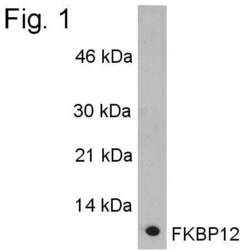
- Experimental details
- Western blot detection of purified FKBP12 after immunoprecipatation on a 15% gel.
Supportive validation
- Submitted by
- Invitrogen Antibodies (provider)
- Main image
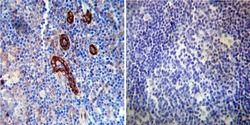
- Experimental details
- Immunohistochemistry was performed on normal deparaffinized human Tonsil tissue. To expose target proteins, heat induced antigen retrieval was performed using 10mM sodium citrate (pH6.0) buffer, microwaved for 8-15 minutes. Following antigen retrieval tissues were blocked in 3% BSA-PBS for 30 minutes at room temperature. Tissues were then probed at a dilution of 1:50 with a rabbit polyclonal antibody recognizing FKBP12 (Product # PA1-026A) or without primary antibody (negative control) overnight at 4°C in a humidified chamber. Tissues were washed extensively with PBST and endogenous peroxidase activity was quenched with a peroxidase suppressor. Detection was performed using a biotin-conjugated secondary antibody and SA-HRP, followed by colorimetric detection using DAB. Tissues were counterstained with hematoxylin and prepped for mounting.
- Submitted by
- Invitrogen Antibodies (provider)
- Main image
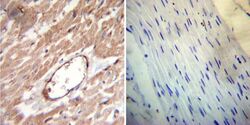
- Experimental details
- Immunohistochemistry was performed on normal deparaffinized human Heart tissue. To expose target proteins, heat induced antigen retrieval was performed using 10mM sodium citrate (pH6.0) buffer, microwaved for 8-15 minutes. Following antigen retrieval tissues were blocked in 3% BSA-PBS for 30 minutes at room temperature. Tissues were then probed at a dilution of 1:20 with a rabbit polyclonal antibody recognizing FKBP12 (Product # PA1-026A) or without primary antibody (negative control) overnight at 4°C in a humidified chamber. Tissues were washed extensively with PBST and endogenous peroxidase activity was quenched with a peroxidase suppressor. Detection was performed using a biotin-conjugated secondary antibody and SA-HRP, followed by colorimetric detection using DAB. Tissues were counterstained with hematoxylin and prepped for mounting.
- Submitted by
- Invitrogen Antibodies (provider)
- Main image
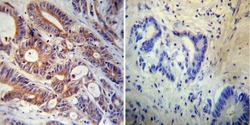
- Experimental details
- Immunohistochemistry was performed on cancer biopsies of deparaffinized human Colon carcinoma tissue. To expose target proteins, heat induced antigen retrieval was performed using 10mM sodium citrate (pH6.0) buffer, microwaved for 8-15 minutes. Following antigen retrieval tissues were blocked in 3% BSA-PBS for 30 minutes at room temperature. Tissues were then probed at a dilution of 1:200 with a rabbit polyclonal antibody recognizing FKBP12 (Product # PA1-026A) or without primary antibody (negative control) overnight at 4°C in a humidified chamber. Tissues were washed extensively with PBST and endogenous peroxidase activity was quenched with a peroxidase suppressor. Detection was performed using a biotin-conjugated secondary antibody and SA-HRP, followed by colorimetric detection using DAB. Tissues were counterstained with hematoxylin and prepped for mounting.
Supportive validation
- Submitted by
- Invitrogen Antibodies (provider)
- Main image
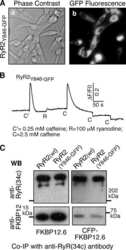
- Experimental details
- NULL
- Submitted by
- Invitrogen Antibodies (provider)
- Main image
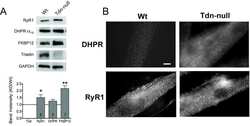
- Experimental details
- NULL
- Submitted by
- Invitrogen Antibodies (provider)
- Main image
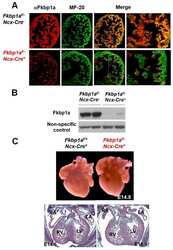
- Experimental details
- NULL
- Submitted by
- Invitrogen Antibodies (provider)
- Main image

- Experimental details
- NULL
- Submitted by
- Invitrogen Antibodies (provider)
- Main image
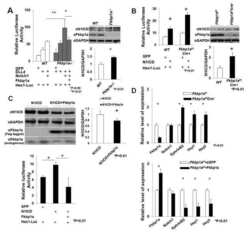
- Experimental details
- NULL
- Submitted by
- Invitrogen Antibodies (provider)
- Main image
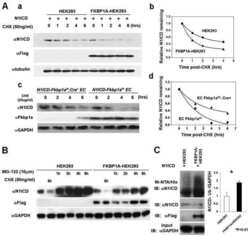
- Experimental details
- NULL
- Submitted by
- Invitrogen Antibodies (provider)
- Main image
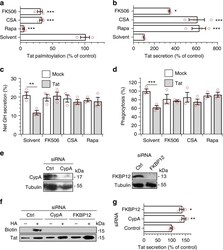
- Experimental details
- Fig. 6 Cyclophilin A and FKBP12 are required for Tat palmitoylation and Tat-mediated inhibition of PI(4,5)P 2 -dependent membrane traffic. a PC12 cells were transfected with Tat-FLAG before treatment for 6 h with 1 uM FK506, 2 uM CSA, 1 uM rapamycin or solvent. Palmitoylation was then assayed using acyl-biotin exchange before band quantification. Results are expressed as biotin/Tat intensity ratio (% of control). b Jurkat T-cells were transfected with Tat before adding drugs for 6 h and assaying Tat secretion by ELISA. c PC12 cells were transfected with GH before drug treatment for 6 h and GH secretion assay. d Human MDMs were treated with the drug for 5 h before assaying phagocytosis of IgG-coated beads. e PC12 cells were transfected with the indicated siRNA before lysis then anti-CypA or anti-FKBP12 then anti-alphatubulin western blot. f PC12 cells were cotransfected with the indicated siRNA and Tat-FLAG before detecting Tat palmitoylation using acyl-biotin exchange. (HA, hydroxylamine). g Jurkat cells were cotransfected with Tat and the indicated siRNA (silencing efficiency is shown in Supplementary Fig. 12b ) and Tat secretion was assayed after 48 h. Data are mean +- SEM, n = 3 independent experiments. The significance of differences with controls was assessed using ANOVA, one-way ( a , b , g ) or two-way ( c , d ) (*** p < 0.001; ** p < 0.01; * p < 0.05)
- Submitted by
- Invitrogen Antibodies (provider)
- Main image
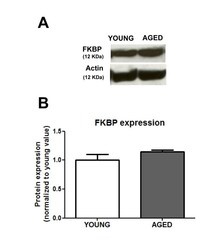
- Experimental details
- Figure 4 Aging does not change significantly the expression of FKBP12 protein ( A ) Representative immunoblotts and ( B ) average +- sem values (arbitrary units) (n=6) of the FKBP12 expression in muscular layer of colon from young and aged guinea pigs.
- Submitted by
- Invitrogen Antibodies (provider)
- Main image
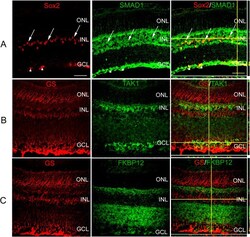
- Experimental details
- Figure 2 Bone morphogenetic protein (BMP) signaling components in the Muller glia of adult mouse retina. A : Sections of 4 week-old retina were subjected to double-label immunofluorescence with antibodies specific for sex determining region Y box 2 (SOX2), which labels Muller glia, retinal astrocytes, and cholinergic amacrine cells, and intracellular members of the BMP pathway SMAD1 . SMAD1 (+) cells were localized to the inner nuclear layer (INL) and ganglion cell layer (GCL) of P30 retina. A subpopulation of SOX2 (+) Muller glia (arrows) and retinal astrocyte cells (arrowheads) were also positive for SMAD1. B : Sections of 4 week-old retina were subjected to double-label immunofluorescence with antibodies for SOX2, and TGF-beta activated kinase 1 (TAK1). Cells positive for the protein TAK1 were found to be localized in the INL and GCL. C : Sections of 4 week-old retina were subjected to double-label immunofluorescence with antibodies for SOX2, and FK506 rapamycin binding protein (FKBP12). FKBP12, also part of the non-canonical BMP pathway, was found to be localized in the INL along with sparse localization in the GCL. Very little to no co-label was seen with glutamine synthetase (GS; +) and TAK1 or FKBP12 (+) cells ( B , C ). n=3 different eyes for each label. Scale Bar A=50 mum applies to all panels.
- Submitted by
- Invitrogen Antibodies (provider)
- Main image
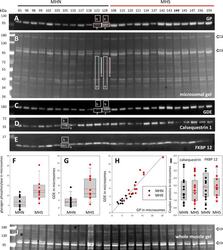
- Experimental details
- Figure 2. Protein content in patients' microsomes. ( A ) Western blot analysis of glycogen phosphorylase (GP) for 25 subjects, in a luminescence scale with black as 0 and white as saturating value. The numbers above each lane are patient identifiers that apply to all 25-lane gels shown in the article. The twelve lanes under the black bar have protein from MHN patients; those under the red bar are from MHS patients, except #144, which was reclassified as MHN. ( B ) Ponceau-stained gel that originated all blots in the figure. A and B illustrate our custom quantitative analysis. The content of every protein quantified in blots was calculated as the signal mass within region a above background (average level in b). Content was normalized for quantity of preparation in the lane dividing by the signal similarly calculated in the gel in B. The signal in B is computed in a large area of the lane to average multiple proteins in the fraction. The method is fully demonstrated in Video 1 . Arrows in B mark two bands, near 100 and 180 kDa, with a visibly greater signal in the MHS group. Their main components were GP and glycogen debranching enzyme (GDE) respectively. ( C-E ) Western blots of GDE, calsequestrin 1 and FKBP12 in different sections of gel B (identified by molecular weight markers at left). ( F and G ) Box plots of GP and GDE content. In both cases the content was greater on average for MHS and the differences significant (data in Table 1 ). ( H ) GP vs. GDE in blots A and C;
- Submitted by
- Invitrogen Antibodies (provider)
- Main image
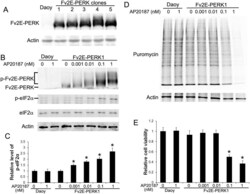
- Experimental details
- Fig 1 Characterization of stably transfected Daoy cell lines that allow for pharmacological controlled activation of PERK. (A) Daoy cells were transfected with the plasmid pIREs-Fv2E-PERK-ZsGreen. We obtained several stably transfected cell lines that were resistant to G418 and expressed various levels of Fv2E-PERK. (B) Western blot analysis showed that AP20187 treatment activated Fv2E-PERK and led to phosphorylation of eIF2alpha. The positions of activated Fv2E-PERK (p-Fv2E-PERK) and inactive Fv2E-PERK proteins were indicated. (C) Densitometry analysis of western blot results showed that AP20187 treatment increased the level of p-eIF2a in Fv2E-PERK1 cells in a dose-dependent manner. The relative protein levels are relative to actin. (D) SUnSET measurement of protein biosynthesis revealed dramatic reduction of protein biosynthesis in Fv2E-PERK1 cells treated with the high dose of AP20187 (0.1-1 nM). Nevertheless, treatment with the low dose of AP20187 (0.001-0.01 nM) only slightly reduced protein biosynthesis in the cells. (E) MTT analysis showed that treatment with the high dose of AP20187 (0. 1-1 nM) significantly inhibited Fv2E-PERK1 cell growth. Nevertheless, treatment with the low dose of AP20187 (0.001-0.01 nM) had no effect on the cell growth. The experiments were repeated at least three times. Error bars represent SD, * P < 0.05.
- Submitted by
- Invitrogen Antibodies (provider)
- Main image
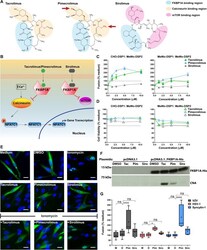
- Experimental details
- 10.1371/journal.ppat.1009022.g002 Fig 2 Inhibition of calcineurin phosphatase activity enhances VZV gB/gH-gL mediated cell fusion. (A) Chemical structures of tacrolimus, pimecrolimus and sirolimus; pimecrolimus group substitutions indicated by red arrows. Regions of interaction with FKBP1A (blue), calcineurin (yellow) and mTOR (red). (B) Schematic of drug interactions with cellular factors. (C and D) Cell fusion and cell viability dose-response curves to tacrolimus, pimecrolimus and sirolimus. CHO-DSP1 or MeWo-DSP1 cells transiently expressing VZV gB/gH[TL]-gL co-cultured with MeWo-DSP2 cells, treated with drug at indicated concentrations. Cell fusion efficiency (C) and cell viability (D) were quantified and normalized to positive controls (medium; no drug). Data are represented as mean +- standard error of the mean (SEM) for >=3 independent experiments. Dash lines indicate the cutoff for statistically significant enhanced fusion or cytotoxicity. (E) Fluorescence microscopy of GFP-NFATC1 nuclear translocation to demonstrate calcineurin phosphatase activity in MeWo cells. GFP-NFATC1 nuclear translocation induced by ionomycin-triggered calcineurin activation (ionomycin; upper right panel) in MeWo cells and prevention by treatment with tacrolimus (+Tacrolimus) and pimecrolimus (+Pimecrolimus). Nuclei stained with Hoechst 33342 (blue) and GFP-NFATC1 (green). Representative fluorescence microscopy images are shown from three independent experiments. Scale bars = 15 mum. (F) Tacrol
- Submitted by
- Invitrogen Antibodies (provider)
- Main image
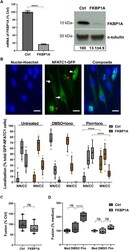
- Experimental details
- 10.1371/journal.ppat.1009022.g003 Fig 3 Pimecrolimus disruption of calcineurin-dependent regulation of gB/gH-gL fusion requires FKBP1A. (A) FKBP1A shRNA knockdown (KD) in MeWo cells. FKBP1A Transcript levels detected by RT-qPCR in MeWo-DSP1 control cells or FKBP1A KD MeWo-DSP1 cells were normalized to housekeeping gene PGM1 and presented as a percentage of control cells, with mean +- SEM from three independent experiment (two-tailed, unpaired t-test, ****, p < 0.0001). Western blot of FKBP1A protein (anti-FKBP1A). FKBP1A band density was normalized to alpha-tubulin in control and FKBP1A KD cells respectively. The ratio of the two values was presented as a percentage of control cells. A representative picture, and mean +- SEM of the ratio from three independent experiments are shown. (B) Quantification of calcineurin phosphatase activity in FKBP1A KD cells using the NFATC1 nuclear translocation assay. MeWo-DSP1 control cells or FKBP1A KD MeWo-DSP1 cells transiently expressing GFP-NFATC1 were untreated (medium) or treated with DMSO or pimecrolimus (Pim, 10 muM) 30 min before ionomycin (Iono, 1 muM; 30 min). Fluorescence microscopy images of GFP-NFATC1 (green), nuclei stained with Hoechst 33342 (blue), and a composite image. Scale bars = 15 mum. Red arrowheads indicate nucleus localization ( N ), white arrowhead indicates diffused localization in both nucleus and cytoplasm ( N/C ), and white arrows indicate cytoplasm localization ( C ). Box and whisker plots of GFP-NFATC1 positi
- Submitted by
- Invitrogen Antibodies (provider)
- Main image
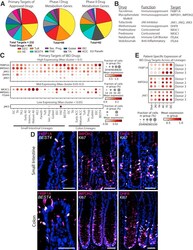
- Experimental details
- Drug targets. ( A ) Pie charts of primary targets of all approved drugs ( left ) and all phase I ( center ) and phase II ( right ) drug metabolism genes expressed in the intestinal epithelium shown by lineage with highest expression. ( B ) Primary targets of drugs used to treat IBD found to have expression in the intestinal epithelium. ( C ) Dotplots showing expression of primary targets of drugs used to treat IBD by lineage split into high-, middle-, and low-expressing tables for better visualization. Note scaling changes between tables. ( D ) Left : In situ hybridization showing BEST4 RNA (white) and immunofluorescence staining for FKBP1A protein (magenta) and nuclei (blue) in human jejunum ( top ) and colon ( bottom ). Center : Immunofluorescence staining for IMPDH2 protein (magenta), KI67 (white), and nuclei (blue) in human jejunum ( top ) and colon ( bottom ). Right : Immunofluorescence staining for DHFR protein (magenta), KI67 (white), and nuclei (blue) in human jejunum ( top ) and colon ( bottom ). Optical slice was 2 mum for all. Scale bars : 50 mum. ( E ) Dotplot showing expression of the top 3 highest-expressed targets of IBD drugs in the intestinal epithelium across regions and split by donor. FKBP1A, FKBP Prolyl Isomerase 1A; IMPDH2, Inosine Monophosphate Dehydrogenase 2; JAK, Janus Kinase; Sec. Prog., Secretory Progenitor.
 Explore
Explore Validate
Validate Learn
Learn Western blot
Western blot Immunoprecipitation
Immunoprecipitation